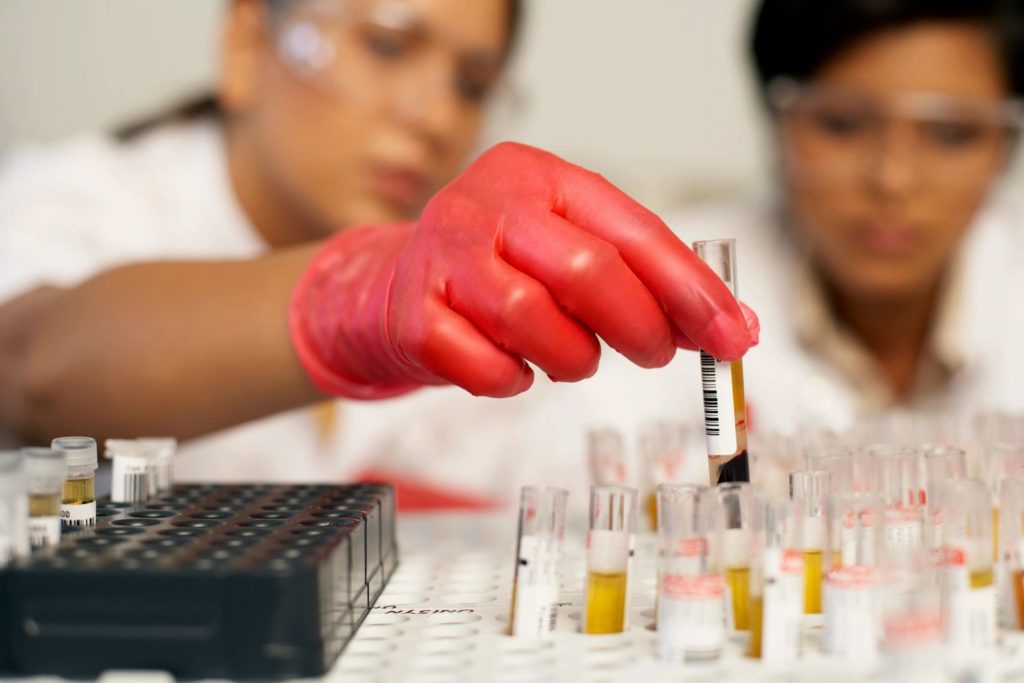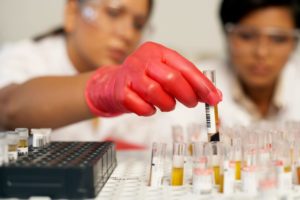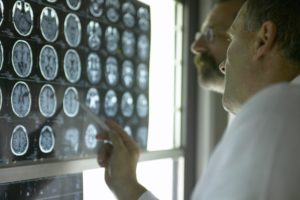
By Megan M. Neal
As the public tracks the development of a viable SARS-CoV-2 (“COVID-19”) vaccine, there has been rampant proliferation of fake COVID-19 cures. Indeed, the Food and Drug Administration (“FDA”) has identified a host of products fraudulently marketed to diagnose, treat, or cure COVID-19.[1] Many of these products are faulty, but relatively harmless: fake antibody testing kits and ineffective hand sanitizer, for instance.[2] However, some scientists, frustrated with the lengthy process of testing and approving vaccines, have sought to develop and administer their own COVID-19 vaccines.[3]
Three projects in particular have garnered public attention. The Rapid Deployment Vaccine Collaborative (“RaDVaC”) has “designed, produced, and self-administered several progressive generations of nasal vaccines against SARS-CoV-2.”[4] Its collaborators are publicly listed, as are instructions for making the vaccine.[5] RaDVaC aims to publicize how to make this vaccine, but does not intend to sell the vaccine.[6] So far, collaborators have administered the vaccine to themselves, family, and friends.[7]
Another collaboration, CoroNope, seeks funding to develop a vaccine for eventual public availability.[8] CoroNope collaborators are anonymous, citing fears of repercussions from employer and the FDA.[9] The group acknowledges that any treatment it creates will likely not “be adopted by the medical community in any official sense.”[10]
Finally, an individual, Johnny T. Stine, developed, sold, and administered a vaccine purporting to (1) immunize uninfected recipients against COVID-19 and (2) cure recipients infected with COVID-19.[11] Stine has a background in antibodies through his company, North Coast Biologics, LLC, which focuses on antibody research.[12] Stine’s COVID-19 vaccine development process was dubious. He “tested the product only on himself and potential[ly] a family member.”[13] After doing so, he deemed the vaccine effective and advertised it—at a cost of $400 per person—on Facebook and LinkedIn.[14] Despite some negative responses, these social media advertisements did generate customers for Stine: he inoculated about thirty individuals living in Washington, Montana, Arizona, and Texas.[15]
The manufacture and distribution of homemade or unapproved drugs is not entirely without precedent. For instance, in 2017 a Chicago pediatrician voluntarily surrendered his medical license after altering allergy shots with cat saliva and vodka.[16] Additionally, courts have held against drug manufacturers that distributed unapproved new drugs.[17] In United States v. X-Otag Plus Tablets,[18] a federal district court held that a new drug could be seized, and the manufacturer could be enjoined from further producing the drug, which had not been approved by the FDA prior to distribution.[19] Ultimately, the court accepted the government’s expert testimony that the drug was not “safe and effective” over testimony from the manufacturer’s experts.[20]
Accordingly, RaDVaC, CoroNope, and Stine’s vaccine present a host of legal issues. In fact, Stine has already faced legal action. The Attorney General of Washington sent him a cease and desist letter in April,[21] and the FDA and the Federal Trade Commission sent him a warning letter in May.[22] In June, the Washington Attorney General pressed charges against Stine under Washington’s unfair and deceptive trade practices statute.[23] The parties ultimately reached a settlement in which Stine agreed to offer restitution to all vaccine recipients by refunding the $400 charge.[24] Additionally, the Consent Decree enjoined Stine from further producing or distributing the vaccine[25] and required him to make a monetary payment.[26]
RaDVaC and CoroNope, on the other hand, have not yet faced disciplinary or legal action.[27] Nonetheless, RaDVaC has sought some legal protection. The group consulted an attorney,[28] and the group lists disclaimers on the document detailing how to develop and administer its vaccine.[29]
These projects are not necessarily immune from liability, though. In March, the Department of Health and Human Services published a Notice of Declaration shielding COVID-19 drug manufacturers from potential liability in some circumstances.[30] However, manufacturers that engage in “willful misconduct” are not shielded from liability.[31] As used in the Notice of Declaration, “willful misconduct” means “an act or omission that is taken (i) intentionally to achieve a wrongful purpose; (ii) knowingly without legal or factual justification; and (iii) in disregard of a known or obvious risk that is so great as to make it highly probable that the harm will outweigh the benefit.”[32] Notably, neither the Notice of Declaration nor the relevant statutory guidelines define “wrongful purpose,” likely leaving the definition to judicial interpretation. Given the exigent need for a COVID-19 vaccine, however, a court may determine that RaDVaC and CoroNope’s decisions to fast-track a their vaccines does not constitute a “wrongful purpose.”
The Federal Food, Drug, and Cosmetic Act (“FD&C Act”) may also pose an issue for homemade vaccine developers. The FD&C Act restricts misbranded and unapproved drugs.[33] It further prohibits introducing such drugs into interstate commerce.[34] Critically for consumers, the FD&C Act does not allow a private right of action.[35]
Additionally, under the Public Health Service Act (“PHS Act”), unlicensed biological products may not be marketed.[36] The PHS Act also bans the use of unlicensed biological products in humans without proper licensing.[37]
Accordingly, the aforementioned collaborations’ actions may result in legal liability. For instance, one RaDVaC collaborator stated that approximately 30 individuals in the United States and other countries have been inoculated with RaDVaC’s vaccine.[38] However, as the collaboration simply publishes instructions for making its vaccine, but does not actually make and distribute it, it remains unclear whether the vaccine has been introduced into interstate commerce. And, as of now, neither RaDVaC nor CoroNope’s products are licensed biological products as required for use in humans by the PHS Act.
Furthermore, should any recipients be injured as a result of these homemade vaccines, these collaborations may face liability for participants’ injuries, depending on whether the collaborations’ actions are deemed “willful misconduct.”
Liability may also depend on the scale of these projects. One RaDVaC project collaborator posits that the group has not yet faced legal or disciplinary proceedings because the project is relatively small. RaDVaC collaborators have not sold or advertised the vaccine beyond friends and family, and the project has received minimal media attention.[39] Accordingly, should these projects expand or change—perhaps by making and selling the vaccines they have designed—their legal situation may change as well.
[1] Fraudulent Coronavirus Disease 2019 (COVID-19) Products, FDA, https://www.fda.gov/consumers/health-fraud-scams/fraudulent-coronavirus-disease-2019-covid-19-products (last updated Sep. 21, 2020).
[2] See id.
[3] Heather Murphy, These Scientists Are Giving Themselves D.I.Y. Coronavirus Vaccines, N.Y. Times (Sept. 1, 2020), https://www.nytimes.com/2020/09/01/science/covid-19-vaccine-diy.html.
[4] RaDVaC Mission, Rapid Deployment Vaccine Collaborative, https://radvac.org (last visited Sept. 22, 2020).
[5] Rapid Deployment Vaccine Collaborative, SARS-CoV-2 (2019-nCoV) Vaccine (2020), https://radvac.org/wp-content/uploads/2020/08/White-Paper-SARS-CoV-2-vaccine-ver-3-0-1.pdf.
[6] Murphy, supra note 3.
[7] Antonio Regalado, Some Scientists Are Taking a DIY Coronavirus Vaccine, and Nobody Knows If It’s Legal or If It Works, MIT Tech. Rev. (July 29, 2020), https://www.technologyreview.com/2020/07/29/1005720/george-church-diy-coronavirus-vaccine/.
[8] CoroNope, CoroNope: A Crowdsourced SARS-CoV-2 Vaccine (2020), https://siasky.net/bACLKGmcmX4NCp47WwOOJf0lU666VLeT5HRWpWVtqZPjEA.
[9] Murphy, supra note 3.
[10] CoroNope, supra note 8, at 1.
[11] Complaint, State v. Stine, No. 20-2-09935-0 SEA (Wash. Super. Ct. June 12, 2020), https://agportal-s3bucket.s3.amazonaws.com/2020_06_12Complaint.pdf.
[12] Id. at 2. Additionally, the Complaint notes that it appears North Coast Biologics was administratively dissolved in 2012, but Stine may have continued to operate under the name of the company. Stine marketed his vaccine through North Coast Biologics’ Facebook page. Id. at 7.
[13] Id. at 8.
[14] Id. at 5.
[15] Id. at 9.
[16] Vikki Ortiz, Doctor Could Lose License After Giving Vaccines Made with Cat Saliva, Vodka, Chi. Trib. (Oct. 20, 2016), https://www.chicagotribune.com/news/ct-flossmoor-doctor-cat-saliva-vaccines-met-20161020-story.html; Search for a License, Ill. Dep’t of Fin. & Pro. Regul., https://ilesonline.idfpr.illinois.gov/DFPR/Lookup/LicenseLookup.aspx (select “Medical Board” License Type and search First Name “Ming” and Last Name “Lin,” from the results select the listing for “Ming Te Lin MD”).
[17] See, e.g., United States v. Pro-Ag, Inc., 968 F.2d 681, 682 (8th Cir. 1992) (holding that products intended for animal use qualified as drugs because they were “intended to alter the structure or function of the body of animals,” and that “the products have never been approved as animal drugs and, therefore, they may not be sold interstate without such approval under section 331(a) of the Federal Food, Drug, and Cosmetic Act”); United States v. Undetermined Qualities of Articles of Drug, 145 F. Supp. 2d 692, 704 (D. Md. 2001) (holding that injunctive relief was proper to bar defendants from manufacturing and distributing misbranded, unapproved new drugs because the government “establish[ed] that the Defendants violated the FDCA and that there exists ‘some cognizable danger of recurrent violation . . . .’” (quoting United States v. W. T. Grant Co., 345 U.S. 629, 633 (1953))); United States v. Richlyn Labs., Inc., 822 F. Supp. 268, 274 (E.D. Pa. 1993) (holding that “[t]he issuance of a permanent injunction enjoining the Defendants from manufacturing, processing, packaging and distributing their drug products until such time as they are in full compliance with Current Good Manufacturing Practices and the Federal Food, Drug, and Cosmetic Act is the only appropriate remedy available to safeguard and protect the public health, safety and welfare”).
[18] 441 F. Supp. 105 (D. Colo. 1977).
[19] Id. at 107.
[20] Id. at 114.
[21] Cease and Desist Letter from Bob Ferguson, Att’y Gen. of Wash., to Johnny T. Stine, North Coast Biologics (Apr. 23, 2020), https://agportal-s3bucket.s3.amazonaws.com/uploadedfiles/Another/News/Press_Releases/Stine-North%20Coast%20Biologics%20Cease%20and%20Desist%20Letter.pdf.
[22] Warning Letter from Center for Biologics Evaluation and Research, FDA, to Johnny T. Stine, North Coast Biologics (May 21, 2020), https://www.fda.gov/inspections-compliance-enforcement-and-criminal-investigations/warning-letters/north-coast-biologics-607532-05212020.
[23] Complaint, State v. Stine, supra note 11, at 9–10.
The Complaint alleges that Stine’s “unfair and deceptive conduct in trade or commerce” included: “misrepresenting the health benefits of the purported “vaccine” [Stine and North Coast Biologics] developed and marketed”; “representing that the product [Stine and North Coast Biologics] developed could vaccinate consumers against COVID-19 without adequate scientific substantiation for these representations”; “offering a product they represented to be a vaccine without adequately testing the product’s effectiveness or safety for use in humans”; “representing that Stine was immune from COVID-19 without adequate scientific administration”; and “offering to cure a human disease, ailment, or condition without a medical license.” Id. Washington’s unfair and deceptive trade practice statute reads in full: “Unfair methods of competition and unfair or deceptive acts or practices in the conduct of any trade or commerce are hereby declared unlawful.” Wash. Rev. Code § 19.86.020.
[24] Consent Decree, State of Washington v. Stine, NO. 20-2-09935-0 SEA, at 4–5 (Wash. King Cty. Super. Ct. 2020), https://agportal-s3bucket.s3.amazonaws.com/2020_06_22ConsentDecree.pdf.
[25] Id. at 3–4.
[26] Id. at 5–6.
[27] Regalado, supra note 7.
[28] Id.
[29] Rapid Deployment Vaccine Collaborative, supra note 5, at 2–5.
[30] Declaration Under the Public Readiness and Emergency Preparedness Act for Medical Countermeasures Against COVID-19, 85 Fed. Reg. 15,198, 15,198 (Mar. 17, 2020). The Public Readiness and Emergency Preparedness Act authorized this action. See 42 U.S.C. §§ 247d-6d, 6e.
[31] Declaration Under the Public Readiness and Emergency Preparedness Act for Medical Countermeasures Against COVID-19, 85 Fed. Reg. at 15,198.
[32] 42 U.S.C. § 247d-6d.
[33] 21 U.S.C. §§ 321–399i.
[34] Id. § 331. The FDA noted these prohibitions in its Warning Letter to Stine.
[35] Id. § 327.
[36] 42 U.S.C. § 262.
[37] Id.; see also 21 U.S.C. § 355(i); 31 C.F.R. § 312 (governing “procedures and requirements governing the use of investigational new drugs, including procedures and requirements for the submission to, and review by, the Food and Drug Administration of investigational new drug applications”). The FDA noted these prohibitions in its Warning Letter to Stine.
[38] Murphy, supra note 3.
[39] Regalado, supra note 7.



